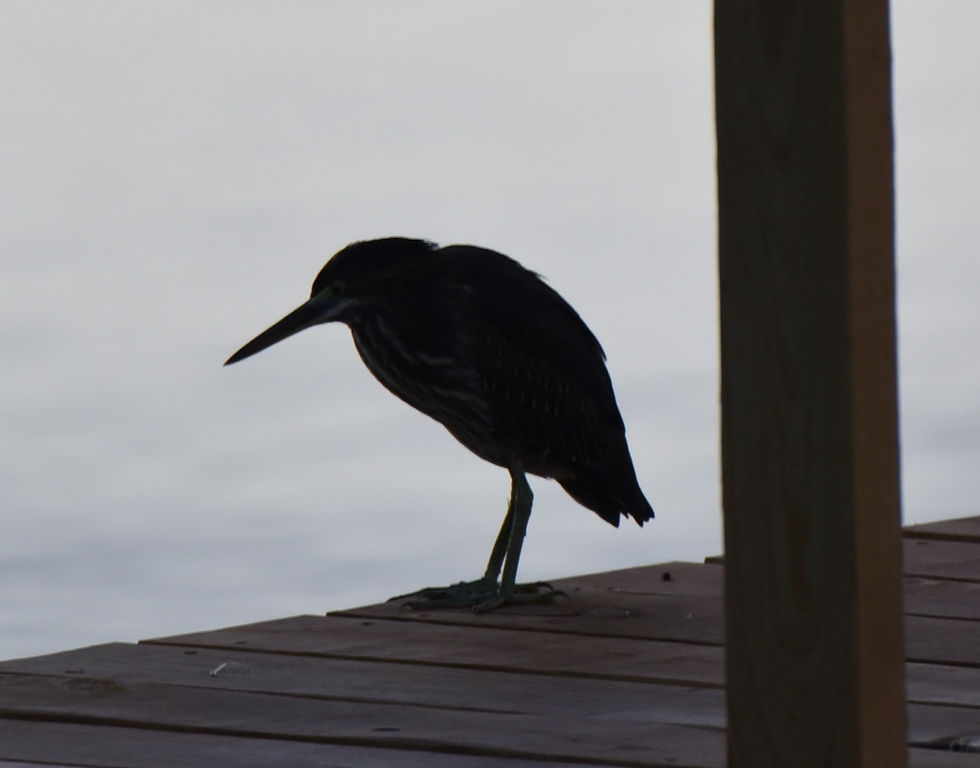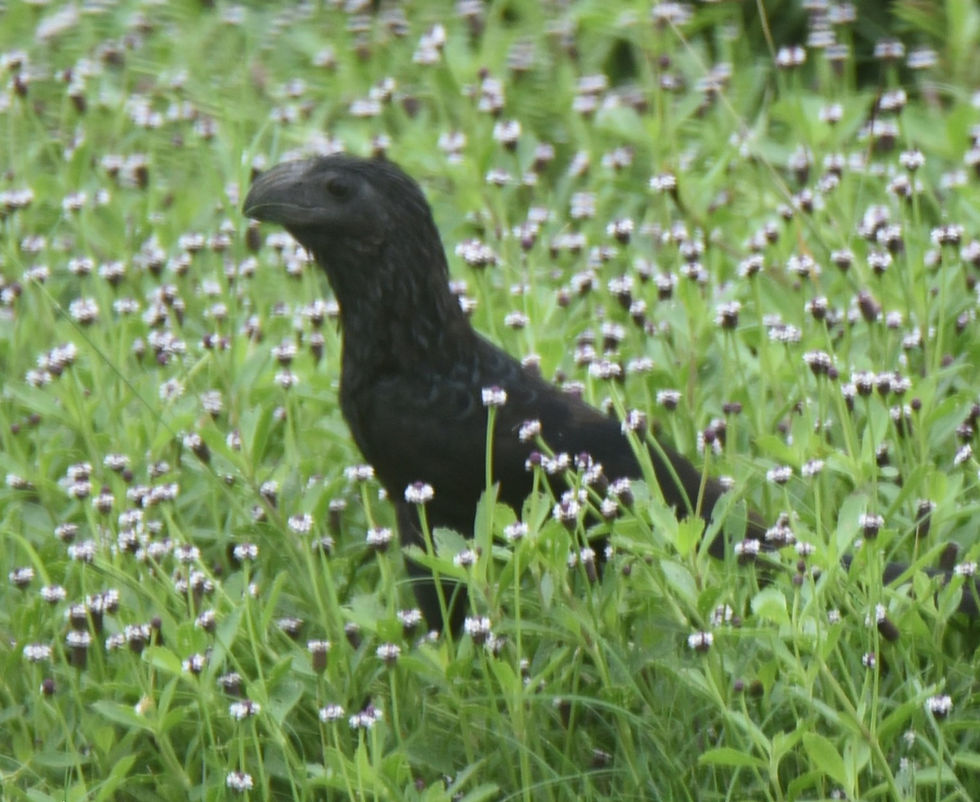Anita’s Blog – Scary, Not Scary
- jjvanm
- Oct 24
- 6 min read
Updated: Oct 25

What better way to proceed into Hallowe’en week than through a bit of nature. Nature is pretty scary – until you learn about it. I was pretty scared the first time I happened upon a cormorant. I was new to Texas and new to nature photography, after years as a military news and documentary photographer.
But this unscary scary missive isn’t about cormorants, yet. I’m starting with crows.

I like crows. They watched over me, lurking, poised on utility wires, about a mile apart as I drove along the highways of southeast Kansas, once upon a time. I miss that – the crows, not Kansas; I’m a Texan now. There is certainly plenty to see as I drive along these Deep South Texas roads and highways of the Rio Grande Valley, but nothing as intimate as a watchful crow.
However, thanks to AI, I have discovered that the Rio Grande Valley has crows. I may even have seen them but didn’t know it.
Here’s what a brief looksee into AI offered: The American Crow, Corvus brachyrhynchos, is a permanent resident found throughout the state (of Texas) in various habitats (but barely south of the San Antonio River, which travels southeast into the Gulf of Mexico, but all north of Corpus Christi, so not in the Valley).
The Tamaulipas Crow, Corvus imparatus, is found in northern Mexico and extends into the southern tip of Texas – that’s us. So, a BOLO (be on the lookout) bird to add to my bird photo bucket list
The Fish Crow, Corvus ossifragus, is in the southeastern part of the state and Louisiana – although birding authorities like the National Audubon Society and Cornell Lab’s All About Birds show the “southeast” to be way up in northeast Texas near Sabine Pass and adjacent to Louisiana.
AI led me to a blog on Birdfy.com about mystical messengers, by NINGLiya, which I think fits into the Hallowe’en spirit: “Spiritually, the crow symbolizes change and transformation, acting as a messenger between worlds and representing wisdom, intuition and magic. Depending on cultural beliefs, a crow can be seen as a bringer of good fortune or an omen of death, while in many traditions it is a symbol of ancient knowledge and a guide to the spiritual world.”
The most common theory associated with a black crow, also according to the Birdfy blog, is that it has come with a message to the physical realm from the spirit realm. The native symbolism attributed to it mainly reflects its power, strength, and transformation.
A very recent article agrees about the messages: “Crows are often seen as messengers from the spirit world, carrying messages about change, death or wisdom from ancestors,” according to another AI-generated article at Alibaba.com, BigBird, October 13, 2025, by ornithologist Emma Wilson.
Whether or not I've ever had a message via crow, I tend to believe in ancient knowledge. I sometimes regard inspiration and breakthrough reasoning – you’ve had them, too, I suspect, those ah-ha! moments – as something genetically generated via some sort of means, (not AI) as ancient knowledge from The Beyond. Perhaps that’s one of the reasons I like crows – for that ancient knowledge. And perhaps I just like crows and other big black birds with attitude.
This Hallowe’en blog showcases big black birds trying to be scary.
Ravens are supposed to be spooky, especially across the pond in England, where the human population isn’t much for celebrating Hallowe’en, although they do have their own ancient (and believable) myths, superstitions and beliefs and other unexplained and unexpected happenings, like crop circles and hill figures (Uffington White Horse), Stonehenge and everything unexplained in Exeter.
The Rio Grande Valley has the Chihuahuan Raven, Corvus cryptoleucus. I was thrilled to snap a photo of one as we left the City of Brownsville Municipal Solid Waste Landfill after a birding trip several years ago.


A few years earlier, and before I purchased my first Texas bird book, well, my first bird book ever, we lived on the Pharr Golf Course. I drove the golfcart. While my husband played golf, I photographed nature, like this scary bird:

It wasn’t until a friend of mine in California urged me to join the Back Yard Bird Count, which I did, when I discovered the identity of the golf course bird, which was a neotropic cormorant, Phalacrocorax brasilianus. Certainly not a scary attack bird. The glowing gullet from the sun shining through and hooked beak had caused my wariness. Although a “sunning of cormorants” like the photo below, might give one pause, however harmless to humans the amazing birds are.

(For those who like collective bird nouns, check out “Rumble at the Resaca,” August 15, 2016, at this link: https://legacyblog.stbctmn.org/2016/08/16/anitas-blog-rumble-at-the-resaca/)
Check out this link, for more information about awesome cormorants: “Great Fishermen of the Resaca,” December 12, 2020, https://legacyblog.stbctmn.org/2020/12/12/anitas-blog-great-fisherman-of-the-resaca/
Once again, praise for a fantastic job, Joseph Connors, South Texas Border Chapter Texas Master Naturalist Webmaster, for archiving the earlier Anita’s Blogs when they were in danger of being lost.
I like our great-tailed grackles, AKA Mexican grackle, Quiscalus mexicanu, too. They have attitude. They like to strut and posture and pretend to be scary. I write about them periodically; the latest article is at this link on our chapter website:


Green Heron, Butorides virescens, are harmless – except to minnows, sunfish, frogs and small snakes. They are a clever wading bird, if not kinda treacherous, like when they’re baiting fish by dropping a twig or insect on the water to entice unsuspecting fish, and then one swift strike and into the Heron’s dark gullet . . . . https://www.stbctmn.org/post/migrating-green-herons-winter-with-our-resident-birds

Groove-billed Ani, Crotophaga sulcirostris, are a fun favorite, a tropical bird in the Cuckoo family with a very long tail and a curved, grooved beak that looks like it could do some damage, if you’re a grasshopper, beetle, cockroach or lizard.

The groove-billed ani is a resident from southern Texas, the northern limits of its range. We’re really lucky to have these birds. They only look dangerous and mysterious; they’re really happy and fun birds. For the most part, they ignore a camera lens following their activity. eBird.org describes anis as bizarre, coal-black cuckoos with long floppy tails. If you can get a clear look at their profile, I think they are quite regal looking. They favor hanging around in small groups, visibly displaying delight in their pursuit of food.
I watched one wafting in the wind as it sat perched on a thin branch of a young black willow tree, homing in on its next meal.

The ani leapt down into a thick patch of Texas frog fruit, bobbed up and down like a jack-in-the-box, most likely chasing insects.

The ani eventually took flight, followed by another, over to a dense growth of trees.
Groove-billed ani breed in Texas from near sea level in thick thorn forests of Texas ebony, mesquite, acacia and mimosa, according to the Texas Breeding Bird Atlas. They build bulky nests in trees such as citrus or mimosa bushes at an average height of about eight feet above the ground and in sugarcane fields where nests may be as low as three feet above the ground. And that’s scary -- the drought, which has put an end to sugar cane production in the Valley.





